UPDATE MARCH 26, 2010: The D10 has been replaced with a new "special edition" that lacks the continuously-variable interface but adds strobe and SOS support. Check out my detailed review of the D10SP for more info.
UPDATE Sept 24, 2008: To see how these Cree Q5 versions stack up against the new Golden Dragon Plus versions, check out that review thread.
Warning: Picture and text heavy!
Reviewer's Note: This is a multi-part review. In Part I of this review, I give an overview of the build characteristics of the D10 and EX10 together, since the circuits are the same, as are most of the general build elements. Detailed comparison reviews of each light to their respective peers are presented in Part II & III (with beamshots, throw/output numbers, runtimes, etc.). In Part IV, I've done a preliminary discussion of both lights. The NiteCore D10 and EX10 were kindly provided for review by EDGETAC and 4sevens of 4sevens.com.
Part I - Common Build and Features

The new NiteCore D10 and EX10 were developed by EDGETAC in collaboration with David (4sevens), and build on the original NiteCore Defender Infinity and Extreme designs. These new lights contain a few innovations rarely seen in mass-produced lights - most especially a MCU (microprocessor controller unit) interface with the innovative McGizmo "piston drive" design that doesn't use a clicky switch. Scroll down for a detailed discussion of the features and functions of the lights.

New NiteCore packaging has been revised to a simpler design consistent with other lights in this price point (D10 shown above). Although the "high quality" box label is likely to produce a few chuckles, it is certainly not a misnomer - the lights are very well made. Package contains a manual, warranty case, and extras include a wrist strap and spare o-rings. The wrist strap seems to be of very high quality and is more useful than the tactical hand cord supplied with the original NDI (seems to be made from a similar quality paracord material).
Body design is smaller than most 1xAA and 1xCR123A/RCR lights, since no tail switch is required. Weights and dimensions (length x width) were measured on my samples as follows:
D10: 42.1g, 89.1mm x 20.3mm
EX10: 41.0g, 76.2mm x 21.5mm

Fit and finish is excellent on my samples - lettering is very clear and sharp, and anodizing is flawless (D10 shown above). Note the knurling is more aggressive than any other Chinese-made light I've seen. This is the first time it really feels like actual knurling (not as severe as Surefire lights, though).

The EX10 (shown above) comes with a stainless steel bezel retaining ring. Since this protrudes a little further than the D10 opening, overall spillbeam width is slightly reduced on the EX10. Beam patterns are otherwise identical since they apparently use the same reflector (which appears to be identical to the original NDI). Scroll down to Parts II & III to see comparisons of the D10 and EX10 with other lights in their classes.
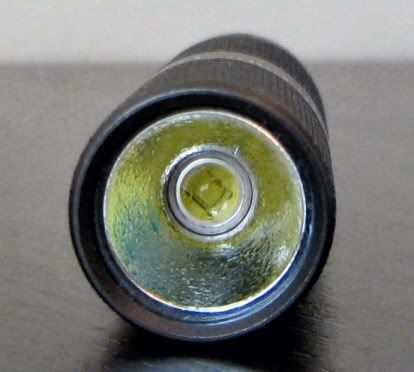
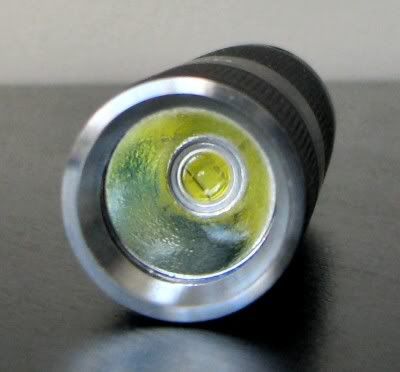
Both lights use a premium white WC-tint Cree Q5 emitter with textured reflector. Both my samples featured emitters with the traditional "yellow" backing around the die (i.e. as opposed to the "silver" versions that come from the Asian Cree assembly plant). There is a small scratch on the reflector of my D10 sample near the emitter - it is not as noticeable as the pic shows, and doesn't interfere with the beam pattern.
Piston Drive
The way the lights work is that the battery is enclosed within a "piston" sleeve which is then in turn pressed against a thick brass contact ring in the head (which should help insure a greater contact interface than a traditional clicky). Switching thus occurs entirely in the head, and current runs through the sleeve and not the body. The contact ring is spring-mounted, and in combination with the MCU can produce different modes and features depending of degree of pressing. This innovative design also allows you to utilize the lights in a couple of different ways (i.e. as both a "twisty" and "clicky" light) - more on that in a moment.
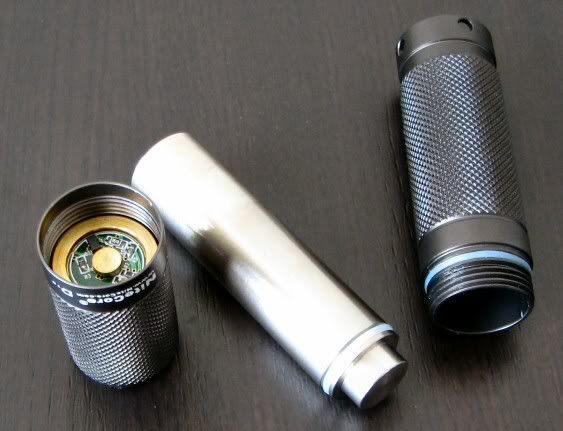
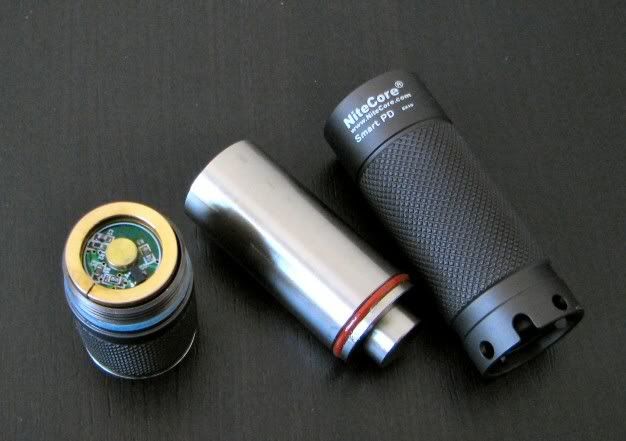
The piston has an o-ring near the protruding button end, to insure a good seal for water-proofness. This also adds a little resistance to the motion (although the springs in the base of the piston and the head are providing most of that). Note that currently-shipping lights are using an overly viscous lube on this o-ring that is causing the piston to seize or stick for some users, leading to inconsistent switching. This is easily fixed by simply wiping off the excess lube upon receipt (and ideally re-applying a lower viscosity lube). David (4sevens) recommends Deoxit, but I find my radio shack Teflon lube works just as well (the one that comes in their "precision oiler"). Again, as usual, less is more when it comes to lubing.
I find the piston-press in general to have good resistance and tactile feel - and while somewhat stiff, it is not overly hard to press when properly lubed. It may take some getting used for those who have only used traditional clickies. The traverse depends on what mode the light is in, as you will need to press further for additional features when in momentary-on mode (again, scroll down for a discussion of the interface). Typically, the traverse is further than on most MCU lights I've used (e.g. Novatac, LiteFlux LF5XT), but still quite familiar feeling.
User Interface
The UI is actually quite straightforward and easy to use. For a good instruction on how to use it, see 4sevens video guide here:
http://www.youtube.com/watch?v=irqhuV8Xo_A
I'm going to describe it in some detail here, because there are a few quirks that some have noted. These are not "bugs" per se, but your enjoyment of the light will be enhanced if you understand what it is doing and why (so you don't accidentally wind up doing somethin you don't want). If you are familiar with the NiteCore NDI and Extreme, you'll find this is basically just a revised interface that uses the tail-press instead of a head twist to activate and change states.
I'll start with the head fully tightened against the body. In this mode, a "click" (i.e. a press and rapid release) of the protruding piston button will turn the light on and leave it on. To jump to the minimum setting, simply double-click (i.e. press and release rapidly twice). To jump to the max setting, hold on the second click of the double-click - what's known as "click-press" for you Novatac fans (i.e. rapid press and release followed by a sustained press). After a 0.5 sec delay, the light will jump to max.
To get the light to ramp up or down, simply press hold the piston button at any time when in fully tightened mode. To get the light to ramp in the other direction, just release and press hold again to re-start the ramp the other way. Note the you may need to do this re-start the ramp after using the "shortcut" double-click or click-press to jump to the extremes (i.e. the light "remembers" the last direction of the ramp, so may not be able to ramp any further in that direction, requiring you re-start it going the other way). This is not a "bug" per se, but a number of users have objected to it. Not a big deal for me personally.
If you are having problems in getting to the various modes consistently, a likely issue is not clicking/pressing quickly enough. It's important to move rapidly between clicks and presses. Users of Novatacs will be familiar with this.
The other way to run the light is as a "twisty" - tighten the light and turn it on, then back off on the head until the light turns off. You can now turn off and on by a twist of the head. But the light also works as a momentary-on this way - press on the piston button to temporarily activate the light, release to turn off. Note the momentary-on level will be whatever you last used when the light was on. You can still jump to max output in momentary-on mode by further depressing the piston button to as far as it will go, and holding it there. The light will jump to max in 0.5 secs.
This later point is significant, because it reveals how the MCU is responding to press depth. When fully tightened, the light is acting like a sustained partial press of the of the piston button. This means that the fully functionality of the multi click/press routines of the fully tightened head are available in momentary mode - but you will need to move quickly between half and full presses of the piston button. For example, to jump to low in momentary mode (i.e. double-click when fully tightened), you would need instead to hold at half-press, rapidly full press back to half-press twice, ending on sustained half-press. Same goes for ramping, etc. Tricky, but do-able with some practice. Personally, I wouldn't bother - I prefer running the light fully tightened and forgoing momentary-on.
Memory Mode
A more significant issue for some, this streamlined interface also has a memory mode that "remembers" only the last level you were in when you turn it off, and always comes back on at this level. This means that if you custom-set your output during the ramp but subsequently jump to min or max at some point, you are now memorized at the new min or max level and your custom-set level is gone. Unlike the more complicated lights that let you pre-set and memorize a number of output modes (usually accessed through multiple click to twist "switches" - like the Novatac, JetBeam IBS, LiteFlux, etc), these NiteCore lights simply retain the last output state - period.
Lock-out
Note that although it's been reported you could "lock-out" the light by unscrewing the head further, this is not a true lock-out. With sufficient pressure on the piston button, I was always able to activate the lights - right up to the point when the head is completely unscrewed. The reasoning is presumably that you are not likely to activate the light with the head significantly unscrewed (i.e. need greater and greater pressure on the piston to activate). But at no point are you insured of no activation, at least in my experience of these samples.
------------------------------------
Part II: NiteCore D10 Comparison Review
For a detailed EX10 review, see Part III below.
Some additional D10 build pics:




To compare it to other members of its class, I've chosen (from left to right), the D10, NiteCore Defender Infinity, Fenix L1D, JetBeam Jet-I IBS, and Jet-II PRO.

Comparison Beamshots
All lights are on 100% on 2650mAh NiMH (Duracell), about 0.5 meters from a white wall.






As you can see, the beam profile is virtually identical to the NDI (as expected, given the same reflector). The D10 is perhaps somewhat less ringy, but this may just be individual variation (my pre-production NDI is smooth as butter, for ex. ).
).
Testing Method: All my output numbers are relative for my home-made light box setup, a la Quickbeam's flashlightreviews.com method. You can directly compare all my relative output values from different reviews - i.e. an output value of "10" in one graph is the same as "10" in another. All runtimes are done under a cooling fan, except for the extended run Lo/Min modes which are done without cooling.
Throw values are the square-root of lux measurements taken at 1 meter from the lens, using a light meter.
Throw/Output Summary Chart:

On the face of things, it looks like the D10 is brighter than the NDI on 14500 on max, and about the same on standard batteries (NiMH/alkaline). Note that this is based on initial brightness though - scroll down to runtimes for a more thorough investigation.
Low mode is definitely lower on the D10. Throw is also consistent with output between the models.
Variable Output Ramping

Although the manufacturer quotes 4 secs for the ramp, it's more like ~5-6 secs in my testing, which makes it about ~2 secs faster than the NDI.
Output/Runtime Comparison:
First, a comparison of all batteries on Max:

And now the detailed breakdown compared to the competition:











Output/Runtime Comments:
UPDATE: Added a second D10 to most of the Hi and Med comparisons above (labelled as #2 on the graphs). As you can see, max output was lower on this sample, but runtime was higher. This likely reflects Vf differences between the emitter samples.
----------------------------------------
Part III: NiteCore EX10 Comparison Review
For a detailed D10 review see Parts II above.
Some additional EX10 build pics:


To compare it to other members of its class, I've chosen (from left to right), the EX10, Fenix P2D, NiteCore Extreme, JetBeam Jet-II PRO IBS, Novatac 120P, LumaPower Incendio.

Comparison Beamshots
All lights are on 100% on RCR (AW Protected, 3.7V), about 0.5 meters from a white wall.

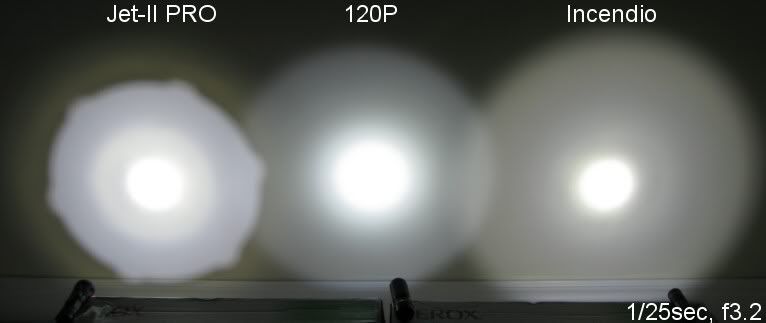


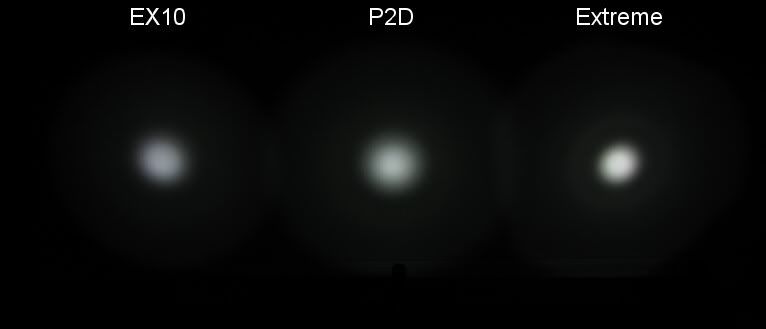

Testing Method: All my output numbers are relative for my home-made light box setup, a la Quickbeam's flashlightreviews.com method. You can directly compare all my relative output values from different reviews - i.e. an output value of "10" in one graph is the same as "10" in another. All runtimes are done under a cooling fan, except for the extended run Lo/Min modes which are done without cooling.
Throw values are the square-root of lux measurements taken at 1 meter from the lens, using a light meter.
Throw/Output Summary Chart:
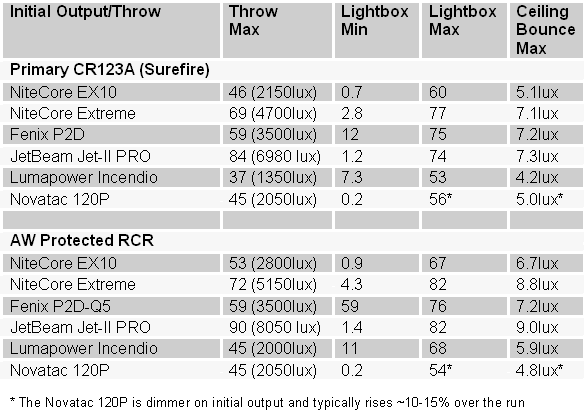
Clearly, the EX10 is not as bright in initial output as the Extreme on either battery type. This is not surprising, given the smaller mass of the EX10 and the need to limit heat production.
Like the D10/NDI comparison, low mode is definitely lower on the EX10 than Extreme. :thumbsup:
EX10 throw is a lot less than the Extreme, due to its smaller reflector (equivalent to the D10/NDI).
Variable Output Ramping

As you can see, ramping time is consistent with the Extreme at ~5 secs.
Output/Runtime Comparison:


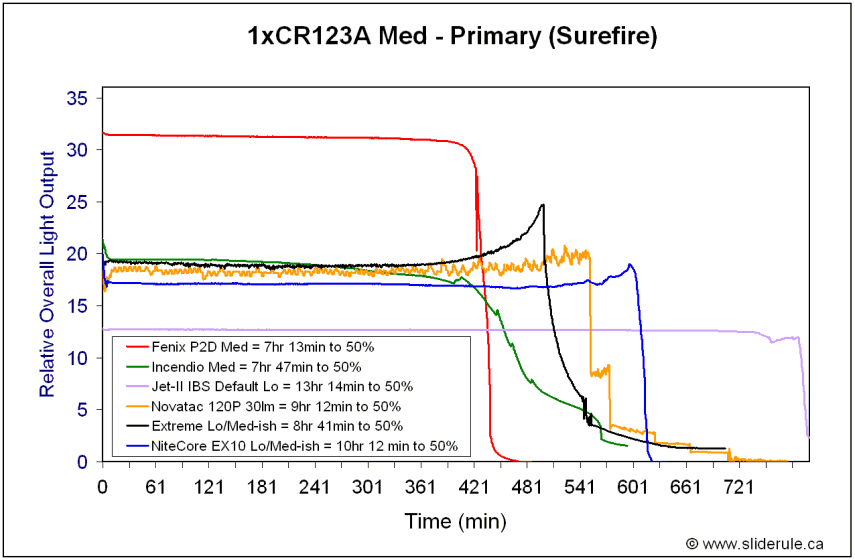





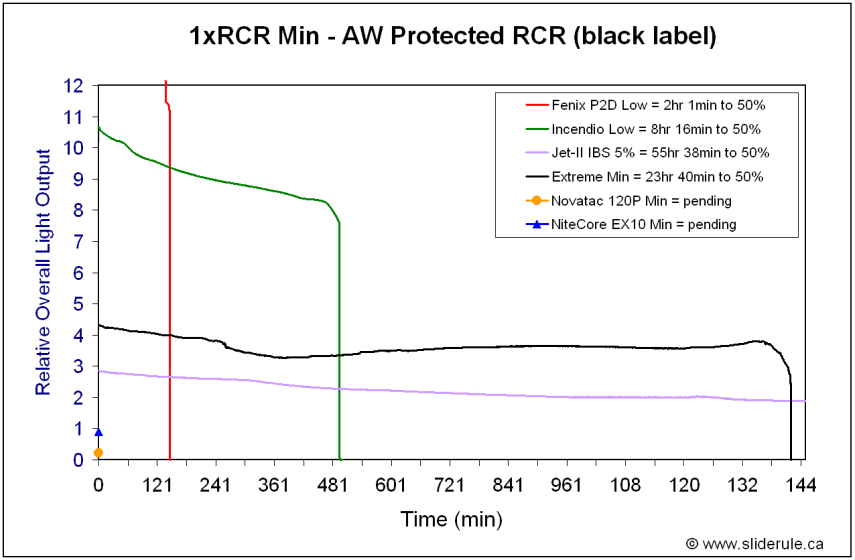
Output/Runtime Comments:
--------------------------
Part IV: Preliminary Discussion
General Observations
The new NiteCores represent an innovative build in the relatively inexpensive (~$55) mass-produced light market. Both lights feature a variant of the McGizmo piston drive design (i.e. no clicky switches). The user interface is an update of the existing NiteCore NDI and Extreme designs, with an emphasis on keeping it simple and uncluttered. The main difference is the "clicky-like" interface over the twist-switching of the earlier lights, but there's also a few new features thrown in (which may or may not appeal to all - see below for further comments).
Output and runtime efficiency
In terms of output/runtime efficiency, these lights are basically the same as the previous NiteCore offerings (NDI and Extreme). As my runtime graphs show quite clearly, the D10 and EX10 have virtually identical runtime characteristics as the earlier models. The only real difference is in the max and min output, and even here the difference is not typically huge.
D10 (relative to NDI):
UPDATE July 14, 2008: There has been some discussion of relative output of the D10 and EX10 to each other and the NDI and Extreme. EDGETAC confirms that the D10 is the same circuit as the NDI, so any difference you see here (e.g. higher initial output on my first D10 sample) is just natural variation among emitters (specifically Vf, which isn't being binned here). My second D10 shows this quite clearly - max output is even lower than my NDI sample, but the runtime characteristics are still exactly the same (i.e. lower output, more runtime). This illustrates that its not output bin that is the issue, but Vf.
The Extreme uses a different circuit with a higher maximum output. The D10/EX10/NDI are all limited in terms of their max output. This is not really an issue for me - I'm always been concerned of overheating in such small lights when run to such extreme levels, so this seems quite reasonable and prudent. But because of the Vf differences, it's possible that you may have a D10 or EX10 that is quite close to the Extreme initially on Li-ion. Note though that the Extreme maintains its initial output level is highly regulated fashion, whereas the D10/EX10/NDI all drop down to a lower regulated level in my testing.
Based on my recent lightbox calibration to the Novatac 120P, I would estimate my D10/EX10 lights produce on initial brightness at Max ~110-130 lumens on primary NiMH/CR123A batteries, and ~130-165 lumens on Li-ion rechargeable 14500/RCR. However, as the runtime graphs show, output on Li-ion drops off over the first few minutes to a regulated level that is remarkably close to the output of NiMH/CR123A (i.e. ~110-135 lumens, I'd estimate). :kiss:
Interface differences
As mentioned, the main UI difference from the earlier NiteCores is the clicky-like interface over the head twist switch. "Shortcuts" to quickly access min and max are also now available, although these will erase any pre-set output mode if you jump to them (i.e. light can only remember last mode it was in). Strobe mode has been removed.
The other main difference is that momentary-on is only available in the "twisty" mode of the new lights (i.e. head loosened). Although the ramping and min shortcut are technically still available in this mode, it is somewhat tricky to activate them given the need to perform multiple half and full quick and long presses. IMO, the light is really designed to run in head fully tightened mode, where it is relatively easy to use the whole feature set (i.e. ramp, max and min shortcuts). This is not a great loss to me, and I'm happy to run my light this way.
This new UI makes it a lot easier to ramp the brightness now, as it can all be done with one hand. However, the inability to keep a "user defined" level is frustrating for some (before, you could easily twist back forth from user defined to max - now, jumping to max will erase user defined). Personally, I'm finding this to be an acceptable trade-off in my early EDCing experience, but I'll keep you posted as I play with it more.
However, the inability to keep a "user defined" level is frustrating for some (before, you could easily twist back forth from user defined to max - now, jumping to max will erase user defined). Personally, I'm finding this to be an acceptable trade-off in my early EDCing experience, but I'll keep you posted as I play with it more.
In comparison to other multi-level lights, the NiteCores are designed for relatively simple and straight-forward operation. But if you like the ability to set multiple independent light modes that you can rapidly switch between, you are out of luck here. For that, I suggest you check out my comparison reviews for discussions of the JetBeam IBS lights, Novatac 120P, or LiteFlux LF5XT.
Personally, I tend to prefer the more versatile multi-level lights with multiple presets. But the simple UI and easy of use of the NiteCores tend to keep drawing me back for EDC purposes. And with the new one-handed ramping on the D10/EX10, the loss of presets is not as big an issue. Of course, YMMV ...
Handling differences
I personally like longer 1AA lights with some knurling, since I typically use them in an overhand way with thumb on the switch (and I have large hands). On that front, the increased knurling on these new lights definitely helps with grip. But I find the EX10 a bit small to carry this way - you are better off using a cigar-type grip given its small size.
I also like the smooth bezel openings in the front, as I found the NDI's crenelated bezel could sometimes get caught on my holder (I typically use a Fenix 1AA or 1CR123A holster, depending). Although the EX10 steel bezel ring is visually attractive, I find it reduces the spillbeam width slightly and introduces an ever-so-slight halo effect during close-up use. Minor issues to be sure, but when coupled with the overall length and hand grip option, I prefer the D10 personally.
FYI, I don't find the piston resistance to be a problem, after cleaning and properly lubing both lights. I recommend everyone do this upon receipt of their lights.
Issues
A minor issue that may need some tweaking involves the brass ring in the head. In case of inconsistent switching, it may need to be adjusted by opening the gap using a fine tip screwdriver or other device (i.e. if the piston sleeve isn't making full contact with it). I didn't have any problems on my D10, but I did notice an issue on my EX10 - a "clicking" sound was heard in the head upon release of the piston switch, and the light was not always disengaging.
I quickly realized the problem - the brass contact ring wasn't always springing back up smoothly after the piston release, but getting stuck or popping up with a delayed reaction (hence the clicking sound). In my case, the problem was easily solved by applying a generous portion of the same low viscosity Teflon lube around the outside of the ring and working it in by repeatedly pressing on the ring. That did the trick for me, but in more severe cases you may need to disassemble the head to more thoroughly lube the spring below this contact ring. This can done by unscrewing the steel retaining ring in the bezel of the EX10 using your thumb or a piece of cloth. The lens and bezel o-ring can then be removed, and the light engine will just fall out the front of the bezel.
Note that I don't consider either this or the overly viscous piston lube issue described earlier to be major problems. IMO, almost all mass-produced lights come with inappropriate lubing (more typically a lack of it). The point here is that with this innovative design, poor lubing may lead to switching/contact issues. EDGETAC is well aware of the issue, and I'm sure they will respond with better lube for the next batch of lights produced. Regardless, I always recommend a proper cleaning and lubing of all new lights as a matter of course.
Another point is the low-level current draw when the piston is making contact but the light is off. This is common in all "on-demand" electronic switches, since the circuit needs constant power to be able to respond to a pressure change at any time (as opposed to traditional clickies, that only complete the current when activated). Eventually, this will drain your battery - but in a properly designed light, it shouldn't be a problem for many months at least. I'm not sure what the estimated current draw is on these lights when off, and unfortunately haven't figured out yet how to get my DMM to directly read it on my samples ... anyone else managed to get a reading yet? :thinking:
Final (Prelimnary) Word
Readers of my reviews will know that while I typically like lights with multiple set-able states (e.g. Novatac 120P, JetBeam IBS, etc.), I have still tended to prefer to EDC my NiteCore NDI.
I haven't played with these new NiteCore lights long enough yet to say whether or not I prefer the UI over the original NDI/Extreme interface. There are pros and cons both ways - time will tell.
But there's no denying that build quality is certainly top-notch on my samples, as good as you could find in this price range. :twothumbs A piston drive on a mass-produced, inexpensive light is enough to justify one of them on the novelty of that feature alone!
I will update this review with more comments as I EDC them a bit more! :wave:
UPDATE July 11, 2008: EDGETAC confirms the D10 and NDI use the same circuit, which explains my nearly identical output/runtime results.
UPDATE July 14, 2008: Additional runtimes for a second D10 added, showing that max output for these lights is somewhat variable (likely due to Vf variation) - but the output/runtime characteristics are highly conserved.
UPDATE Sept 24, 2008: Comparison of these Cree Q5 versions to the new Golden Dragon Plus versions is available here.
UPDATE MARCH 26, 2010: The D10 has been replaced with a new "special edition" that lacks the continuously-variable interface but adds strobe and SOS support. Check out my detailed review of the D10SP for more info.
UPDATE Sept 24, 2008: To see how these Cree Q5 versions stack up against the new Golden Dragon Plus versions, check out that review thread.
Warning: Picture and text heavy!
Reviewer's Note: This is a multi-part review. In Part I of this review, I give an overview of the build characteristics of the D10 and EX10 together, since the circuits are the same, as are most of the general build elements. Detailed comparison reviews of each light to their respective peers are presented in Part II & III (with beamshots, throw/output numbers, runtimes, etc.). In Part IV, I've done a preliminary discussion of both lights. The NiteCore D10 and EX10 were kindly provided for review by EDGETAC and 4sevens of 4sevens.com.
Part I - Common Build and Features

The new NiteCore D10 and EX10 were developed by EDGETAC in collaboration with David (4sevens), and build on the original NiteCore Defender Infinity and Extreme designs. These new lights contain a few innovations rarely seen in mass-produced lights - most especially a MCU (microprocessor controller unit) interface with the innovative McGizmo "piston drive" design that doesn't use a clicky switch. Scroll down for a detailed discussion of the features and functions of the lights.

New NiteCore packaging has been revised to a simpler design consistent with other lights in this price point (D10 shown above). Although the "high quality" box label is likely to produce a few chuckles, it is certainly not a misnomer - the lights are very well made. Package contains a manual, warranty case, and extras include a wrist strap and spare o-rings. The wrist strap seems to be of very high quality and is more useful than the tactical hand cord supplied with the original NDI (seems to be made from a similar quality paracord material).
Body design is smaller than most 1xAA and 1xCR123A/RCR lights, since no tail switch is required. Weights and dimensions (length x width) were measured on my samples as follows:
D10: 42.1g, 89.1mm x 20.3mm
EX10: 41.0g, 76.2mm x 21.5mm

Fit and finish is excellent on my samples - lettering is very clear and sharp, and anodizing is flawless (D10 shown above). Note the knurling is more aggressive than any other Chinese-made light I've seen. This is the first time it really feels like actual knurling (not as severe as Surefire lights, though).

The EX10 (shown above) comes with a stainless steel bezel retaining ring. Since this protrudes a little further than the D10 opening, overall spillbeam width is slightly reduced on the EX10. Beam patterns are otherwise identical since they apparently use the same reflector (which appears to be identical to the original NDI). Scroll down to Parts II & III to see comparisons of the D10 and EX10 with other lights in their classes.


Both lights use a premium white WC-tint Cree Q5 emitter with textured reflector. Both my samples featured emitters with the traditional "yellow" backing around the die (i.e. as opposed to the "silver" versions that come from the Asian Cree assembly plant). There is a small scratch on the reflector of my D10 sample near the emitter - it is not as noticeable as the pic shows, and doesn't interfere with the beam pattern.
Piston Drive
The way the lights work is that the battery is enclosed within a "piston" sleeve which is then in turn pressed against a thick brass contact ring in the head (which should help insure a greater contact interface than a traditional clicky). Switching thus occurs entirely in the head, and current runs through the sleeve and not the body. The contact ring is spring-mounted, and in combination with the MCU can produce different modes and features depending of degree of pressing. This innovative design also allows you to utilize the lights in a couple of different ways (i.e. as both a "twisty" and "clicky" light) - more on that in a moment.


The piston has an o-ring near the protruding button end, to insure a good seal for water-proofness. This also adds a little resistance to the motion (although the springs in the base of the piston and the head are providing most of that). Note that currently-shipping lights are using an overly viscous lube on this o-ring that is causing the piston to seize or stick for some users, leading to inconsistent switching. This is easily fixed by simply wiping off the excess lube upon receipt (and ideally re-applying a lower viscosity lube). David (4sevens) recommends Deoxit, but I find my radio shack Teflon lube works just as well (the one that comes in their "precision oiler"). Again, as usual, less is more when it comes to lubing.
I find the piston-press in general to have good resistance and tactile feel - and while somewhat stiff, it is not overly hard to press when properly lubed. It may take some getting used for those who have only used traditional clickies. The traverse depends on what mode the light is in, as you will need to press further for additional features when in momentary-on mode (again, scroll down for a discussion of the interface). Typically, the traverse is further than on most MCU lights I've used (e.g. Novatac, LiteFlux LF5XT), but still quite familiar feeling.
User Interface
The UI is actually quite straightforward and easy to use. For a good instruction on how to use it, see 4sevens video guide here:
http://www.youtube.com/watch?v=irqhuV8Xo_A
I'm going to describe it in some detail here, because there are a few quirks that some have noted. These are not "bugs" per se, but your enjoyment of the light will be enhanced if you understand what it is doing and why (so you don't accidentally wind up doing somethin you don't want). If you are familiar with the NiteCore NDI and Extreme, you'll find this is basically just a revised interface that uses the tail-press instead of a head twist to activate and change states.
I'll start with the head fully tightened against the body. In this mode, a "click" (i.e. a press and rapid release) of the protruding piston button will turn the light on and leave it on. To jump to the minimum setting, simply double-click (i.e. press and release rapidly twice). To jump to the max setting, hold on the second click of the double-click - what's known as "click-press" for you Novatac fans (i.e. rapid press and release followed by a sustained press). After a 0.5 sec delay, the light will jump to max.
To get the light to ramp up or down, simply press hold the piston button at any time when in fully tightened mode. To get the light to ramp in the other direction, just release and press hold again to re-start the ramp the other way. Note the you may need to do this re-start the ramp after using the "shortcut" double-click or click-press to jump to the extremes (i.e. the light "remembers" the last direction of the ramp, so may not be able to ramp any further in that direction, requiring you re-start it going the other way). This is not a "bug" per se, but a number of users have objected to it. Not a big deal for me personally.
If you are having problems in getting to the various modes consistently, a likely issue is not clicking/pressing quickly enough. It's important to move rapidly between clicks and presses. Users of Novatacs will be familiar with this.
The other way to run the light is as a "twisty" - tighten the light and turn it on, then back off on the head until the light turns off. You can now turn off and on by a twist of the head. But the light also works as a momentary-on this way - press on the piston button to temporarily activate the light, release to turn off. Note the momentary-on level will be whatever you last used when the light was on. You can still jump to max output in momentary-on mode by further depressing the piston button to as far as it will go, and holding it there. The light will jump to max in 0.5 secs.
This later point is significant, because it reveals how the MCU is responding to press depth. When fully tightened, the light is acting like a sustained partial press of the of the piston button. This means that the fully functionality of the multi click/press routines of the fully tightened head are available in momentary mode - but you will need to move quickly between half and full presses of the piston button. For example, to jump to low in momentary mode (i.e. double-click when fully tightened), you would need instead to hold at half-press, rapidly full press back to half-press twice, ending on sustained half-press. Same goes for ramping, etc. Tricky, but do-able with some practice. Personally, I wouldn't bother - I prefer running the light fully tightened and forgoing momentary-on.
Memory Mode
A more significant issue for some, this streamlined interface also has a memory mode that "remembers" only the last level you were in when you turn it off, and always comes back on at this level. This means that if you custom-set your output during the ramp but subsequently jump to min or max at some point, you are now memorized at the new min or max level and your custom-set level is gone. Unlike the more complicated lights that let you pre-set and memorize a number of output modes (usually accessed through multiple click to twist "switches" - like the Novatac, JetBeam IBS, LiteFlux, etc), these NiteCore lights simply retain the last output state - period.
Lock-out
Note that although it's been reported you could "lock-out" the light by unscrewing the head further, this is not a true lock-out. With sufficient pressure on the piston button, I was always able to activate the lights - right up to the point when the head is completely unscrewed. The reasoning is presumably that you are not likely to activate the light with the head significantly unscrewed (i.e. need greater and greater pressure on the piston to activate). But at no point are you insured of no activation, at least in my experience of these samples.
------------------------------------
Part II: NiteCore D10 Comparison Review
For a detailed EX10 review, see Part III below.
Some additional D10 build pics:




To compare it to other members of its class, I've chosen (from left to right), the D10, NiteCore Defender Infinity, Fenix L1D, JetBeam Jet-I IBS, and Jet-II PRO.

Comparison Beamshots
All lights are on 100% on 2650mAh NiMH (Duracell), about 0.5 meters from a white wall.






As you can see, the beam profile is virtually identical to the NDI (as expected, given the same reflector). The D10 is perhaps somewhat less ringy, but this may just be individual variation (my pre-production NDI is smooth as butter, for ex.
Testing Method: All my output numbers are relative for my home-made light box setup, a la Quickbeam's flashlightreviews.com method. You can directly compare all my relative output values from different reviews - i.e. an output value of "10" in one graph is the same as "10" in another. All runtimes are done under a cooling fan, except for the extended run Lo/Min modes which are done without cooling.
Throw values are the square-root of lux measurements taken at 1 meter from the lens, using a light meter.
Throw/Output Summary Chart:

On the face of things, it looks like the D10 is brighter than the NDI on 14500 on max, and about the same on standard batteries (NiMH/alkaline). Note that this is based on initial brightness though - scroll down to runtimes for a more thorough investigation.
Low mode is definitely lower on the D10. Throw is also consistent with output between the models.
Variable Output Ramping

Although the manufacturer quotes 4 secs for the ramp, it's more like ~5-6 secs in my testing, which makes it about ~2 secs faster than the NDI.
Output/Runtime Comparison:
First, a comparison of all batteries on Max:

And now the detailed breakdown compared to the competition:











Output/Runtime Comments:
- Although initially brighter on max on 14500, the D10 fairly quickly drops down to the max regulated level of the NDI.
- On NiMH and 14500, runtime characteristics seem exactly the same between D10 and NDI, when matched for initial output
- D10 runtimes are lower on alkalines - likely due to Vf variation among emitters.
UPDATE: Added a second D10 to most of the Hi and Med comparisons above (labelled as #2 on the graphs). As you can see, max output was lower on this sample, but runtime was higher. This likely reflects Vf differences between the emitter samples.
----------------------------------------
Part III: NiteCore EX10 Comparison Review
For a detailed D10 review see Parts II above.
Some additional EX10 build pics:


To compare it to other members of its class, I've chosen (from left to right), the EX10, Fenix P2D, NiteCore Extreme, JetBeam Jet-II PRO IBS, Novatac 120P, LumaPower Incendio.

Comparison Beamshots
All lights are on 100% on RCR (AW Protected, 3.7V), about 0.5 meters from a white wall.






Testing Method: All my output numbers are relative for my home-made light box setup, a la Quickbeam's flashlightreviews.com method. You can directly compare all my relative output values from different reviews - i.e. an output value of "10" in one graph is the same as "10" in another. All runtimes are done under a cooling fan, except for the extended run Lo/Min modes which are done without cooling.
Throw values are the square-root of lux measurements taken at 1 meter from the lens, using a light meter.
Throw/Output Summary Chart:

Clearly, the EX10 is not as bright in initial output as the Extreme on either battery type. This is not surprising, given the smaller mass of the EX10 and the need to limit heat production.
Like the D10/NDI comparison, low mode is definitely lower on the EX10 than Extreme. :thumbsup:
EX10 throw is a lot less than the Extreme, due to its smaller reflector (equivalent to the D10/NDI).
Variable Output Ramping

As you can see, ramping time is consistent with the Extreme at ~5 secs.
Output/Runtime Comparison:









Output/Runtime Comments:
- Although not as bright as the Extreme on either CR123A primaries or RCR, the EX10 seems to have the exact same runtime characteristics as the Extreme when matched for initial output
--------------------------
Part IV: Preliminary Discussion
General Observations
The new NiteCores represent an innovative build in the relatively inexpensive (~$55) mass-produced light market. Both lights feature a variant of the McGizmo piston drive design (i.e. no clicky switches). The user interface is an update of the existing NiteCore NDI and Extreme designs, with an emphasis on keeping it simple and uncluttered. The main difference is the "clicky-like" interface over the twist-switching of the earlier lights, but there's also a few new features thrown in (which may or may not appeal to all - see below for further comments).
Output and runtime efficiency
In terms of output/runtime efficiency, these lights are basically the same as the previous NiteCore offerings (NDI and Extreme). As my runtime graphs show quite clearly, the D10 and EX10 have virtually identical runtime characteristics as the earlier models. The only real difference is in the max and min output, and even here the difference is not typically huge.
D10 (relative to NDI):
- Identical max output on standard batteries (NiMH/Alkaline)
- Slight increase in max output on 14500, but this rapidly drops off to match the max regulated output of the NDI.
- Lower min output on all battery types. :thumbsup:
- D10 had reduced runtimes on alkaline in my first sample - likely due to Vf variation among samples (confirmed by EDGETAC).
- UPDATE: I've run a number of tests with another D10, and you'll see max output is ~10% less - but with corresponding longer runtime.
- Ramping time shortened by ~2 secs (i.e. ~5-6 secs on my D10)
- Reduced max output on both primary CR123A and RCR, as expected for a smaller build light.
- Min output is also noticeably lower on both battery types. :thumbsup:
- Output/runtime virtually identical at all levels tested on both battery types (up to the max of the EX10, of course).
- Ramping time virtually the same (i.e. ~5-6 secs on my EX10)
UPDATE July 14, 2008: There has been some discussion of relative output of the D10 and EX10 to each other and the NDI and Extreme. EDGETAC confirms that the D10 is the same circuit as the NDI, so any difference you see here (e.g. higher initial output on my first D10 sample) is just natural variation among emitters (specifically Vf, which isn't being binned here). My second D10 shows this quite clearly - max output is even lower than my NDI sample, but the runtime characteristics are still exactly the same (i.e. lower output, more runtime). This illustrates that its not output bin that is the issue, but Vf.
The Extreme uses a different circuit with a higher maximum output. The D10/EX10/NDI are all limited in terms of their max output. This is not really an issue for me - I'm always been concerned of overheating in such small lights when run to such extreme levels, so this seems quite reasonable and prudent. But because of the Vf differences, it's possible that you may have a D10 or EX10 that is quite close to the Extreme initially on Li-ion. Note though that the Extreme maintains its initial output level is highly regulated fashion, whereas the D10/EX10/NDI all drop down to a lower regulated level in my testing.
Based on my recent lightbox calibration to the Novatac 120P, I would estimate my D10/EX10 lights produce on initial brightness at Max ~110-130 lumens on primary NiMH/CR123A batteries, and ~130-165 lumens on Li-ion rechargeable 14500/RCR. However, as the runtime graphs show, output on Li-ion drops off over the first few minutes to a regulated level that is remarkably close to the output of NiMH/CR123A (i.e. ~110-135 lumens, I'd estimate). :kiss:
Interface differences
As mentioned, the main UI difference from the earlier NiteCores is the clicky-like interface over the head twist switch. "Shortcuts" to quickly access min and max are also now available, although these will erase any pre-set output mode if you jump to them (i.e. light can only remember last mode it was in). Strobe mode has been removed.
The other main difference is that momentary-on is only available in the "twisty" mode of the new lights (i.e. head loosened). Although the ramping and min shortcut are technically still available in this mode, it is somewhat tricky to activate them given the need to perform multiple half and full quick and long presses. IMO, the light is really designed to run in head fully tightened mode, where it is relatively easy to use the whole feature set (i.e. ramp, max and min shortcuts). This is not a great loss to me, and I'm happy to run my light this way.
This new UI makes it a lot easier to ramp the brightness now, as it can all be done with one hand.
In comparison to other multi-level lights, the NiteCores are designed for relatively simple and straight-forward operation. But if you like the ability to set multiple independent light modes that you can rapidly switch between, you are out of luck here. For that, I suggest you check out my comparison reviews for discussions of the JetBeam IBS lights, Novatac 120P, or LiteFlux LF5XT.
Personally, I tend to prefer the more versatile multi-level lights with multiple presets. But the simple UI and easy of use of the NiteCores tend to keep drawing me back for EDC purposes. And with the new one-handed ramping on the D10/EX10, the loss of presets is not as big an issue. Of course, YMMV ...
Handling differences
I personally like longer 1AA lights with some knurling, since I typically use them in an overhand way with thumb on the switch (and I have large hands). On that front, the increased knurling on these new lights definitely helps with grip. But I find the EX10 a bit small to carry this way - you are better off using a cigar-type grip given its small size.
I also like the smooth bezel openings in the front, as I found the NDI's crenelated bezel could sometimes get caught on my holder (I typically use a Fenix 1AA or 1CR123A holster, depending). Although the EX10 steel bezel ring is visually attractive, I find it reduces the spillbeam width slightly and introduces an ever-so-slight halo effect during close-up use. Minor issues to be sure, but when coupled with the overall length and hand grip option, I prefer the D10 personally.
FYI, I don't find the piston resistance to be a problem, after cleaning and properly lubing both lights. I recommend everyone do this upon receipt of their lights.
Issues
A minor issue that may need some tweaking involves the brass ring in the head. In case of inconsistent switching, it may need to be adjusted by opening the gap using a fine tip screwdriver or other device (i.e. if the piston sleeve isn't making full contact with it). I didn't have any problems on my D10, but I did notice an issue on my EX10 - a "clicking" sound was heard in the head upon release of the piston switch, and the light was not always disengaging.
I quickly realized the problem - the brass contact ring wasn't always springing back up smoothly after the piston release, but getting stuck or popping up with a delayed reaction (hence the clicking sound). In my case, the problem was easily solved by applying a generous portion of the same low viscosity Teflon lube around the outside of the ring and working it in by repeatedly pressing on the ring. That did the trick for me, but in more severe cases you may need to disassemble the head to more thoroughly lube the spring below this contact ring. This can done by unscrewing the steel retaining ring in the bezel of the EX10 using your thumb or a piece of cloth. The lens and bezel o-ring can then be removed, and the light engine will just fall out the front of the bezel.
Note that I don't consider either this or the overly viscous piston lube issue described earlier to be major problems. IMO, almost all mass-produced lights come with inappropriate lubing (more typically a lack of it). The point here is that with this innovative design, poor lubing may lead to switching/contact issues. EDGETAC is well aware of the issue, and I'm sure they will respond with better lube for the next batch of lights produced. Regardless, I always recommend a proper cleaning and lubing of all new lights as a matter of course.
Another point is the low-level current draw when the piston is making contact but the light is off. This is common in all "on-demand" electronic switches, since the circuit needs constant power to be able to respond to a pressure change at any time (as opposed to traditional clickies, that only complete the current when activated). Eventually, this will drain your battery - but in a properly designed light, it shouldn't be a problem for many months at least. I'm not sure what the estimated current draw is on these lights when off, and unfortunately haven't figured out yet how to get my DMM to directly read it on my samples ... anyone else managed to get a reading yet? :thinking:
Final (Prelimnary) Word
Readers of my reviews will know that while I typically like lights with multiple set-able states (e.g. Novatac 120P, JetBeam IBS, etc.), I have still tended to prefer to EDC my NiteCore NDI.
I haven't played with these new NiteCore lights long enough yet to say whether or not I prefer the UI over the original NDI/Extreme interface. There are pros and cons both ways - time will tell.
But there's no denying that build quality is certainly top-notch on my samples, as good as you could find in this price range. :twothumbs A piston drive on a mass-produced, inexpensive light is enough to justify one of them on the novelty of that feature alone!
I will update this review with more comments as I EDC them a bit more! :wave:
UPDATE July 11, 2008: EDGETAC confirms the D10 and NDI use the same circuit, which explains my nearly identical output/runtime results.
UPDATE July 14, 2008: Additional runtimes for a second D10 added, showing that max output for these lights is somewhat variable (likely due to Vf variation) - but the output/runtime characteristics are highly conserved.
UPDATE Sept 24, 2008: Comparison of these Cree Q5 versions to the new Golden Dragon Plus versions is available here.
UPDATE MARCH 26, 2010: The D10 has been replaced with a new "special edition" that lacks the continuously-variable interface but adds strobe and SOS support. Check out my detailed review of the D10SP for more info.
Last edited:




 .
. 